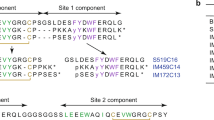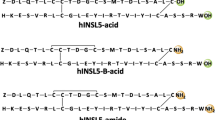Abstract
As part of our aim to investigate the contribution of the tyrosine residue found in the 14 position of the A-chain to the biological activity of insulin, we have synthesized six insulin analogues in which the A14 Tyr has been substituted by a variety of amino acid residues. We have selected three hydrophilic and charged residues—glutamic acid, histidine, and lysine—as well as three hydrophobic residues—cycloleucine, cyclohexylalanine, and naphthyl-(1)-alanine—to replace the A14 Tyr. All six analogues exhibit full agonist activity, reaching the same maximum stimulation of lipogenesis as is achieved with procine insulin. The potency for five of the six analogues, [A14 Glu]-, [A14 His]-, [A14 Lys]-, [A14 cycloleucine]-, and [A14 naphthyl-(1)-alanine]-insulins in receptor binding assays ranges from 40–71% and in stimulation of lipogenesis ranges from 35-120% relative to porcine insulin. In contrast, the potency of the sixth analogue, [A14 cyclohexylalanine]insulin, in both types of assays is less than 1% of the natural hormone. The retention time on reversed-phase high-performance liquid chromatography for the first five analogues is similar to that of bovine insulin, whereas for the sixth analogue, [A14 cyclohexylalanine]insulin, it is approximately 11 min longer than that of the natural hormone. This suggests a profound change in conformation of the latter analogue. Apparently, the A14 position of insulin can tolerate a wide latitude of structural alterations without substantial decrease in potency. This suggests that the A14 position does not participate directly in insulin receptor interaction. Only when a substitution which has the potential to disrupt the conformation of the molecule is made at this position, is the affinity for the receptor, and hence the biological potency, greatly reduced.
Similar content being viewed by others
References
Barany, G., and Merrifield, R. B. (1980). InThe Peptides (Gross, E., and Meienhofer, J., eds.), Vol. 2, Academic Press, New York, pp. 3–284.
Blundell, T. L., Dodson, G. G., Dodson, E., Hodgkin, D. C., and Vijayan, M. (1977).Rec. Prog. Horm. Res. 27, 1–40.
Blundell, T. L., Dodson, G. G., Hodgkin, D. C., and Mercola, E. (1972).Adv. Protein Chem. 26, 279–402.
Blundell, T. L., and Humbel, R. E. (1980),Nature 287, 781–787.
Burke, G. T., Hu, S. Q., Ohta, N., Schwartz, G. P., Zong, L., and Katsoyannis, P. G. (1990).Biochem. Biophys. Res. Commun. 173, 982–987.
Chance, R. E., Hoffman, J. A., Kroef, E. P., Johnson, M. G., Schirmer, E. W., Bromer, W. W., Ross, M. J., and Wetzel, R. (1981).Proc. Am. Pept. Symp. 7, 721–728.
Danho, W., Sasaki, A., Büllesbach, E., Gattner, H.-G., and Wollmer, A. (1980),Hoppe-Seyler's Z. Physiol. Chem. 361, 747–754.
Dayhoff, M. D. (1969).Atlas of Protein Sequence and Structure, Vol. 4, National Biochemical Research Foundation, Silver Spring, Maryland, p. D-164.
DiMarchi, R. D., Tam, J. P., Kent, S. B. H., and Merrifield, R. B. (1982).Int. J. Pept. Protein Res. 19, 88–93.
Ferderigos, N., Burke, G. T., Kitagawa, K., and Katsoyannis, P. G. (1983).J. Protein Chem. 2, 147–170.
Gliemann, J., Sonne, O., Linde, S., and Hansen, B. (1979).Biochem. Biophys. Res. Commun. 87, 1183–1190.
Hagenmaier, H., and Frank, H. (1972).Hoppe Seyler's Z. Physiol. Chem. 353, 1973–1976.
Hamlin, J., and Arquilla, E. R. (1974).J. Biol. Chem. 249, 21–32.
Joshi, S., Burke, G. T., and Katsoyannis, P. G., (1990).J. Protein Chem. 9, 235–246.
Kaiser, E., Colescott, R. L., Bossinger, C. D., and Cook, P. I. (1970),Anal. Biochem. 34, 595–598.
Katsoyannis, P. G., Tometsko, A., Zalut, C., Johnson, S., and Trakatellis, A. C. (1967a).Biochemistry 6, 2635–2641.
Katsoyannis, P. G., Trakatellis, A. C., Zalut, C., Johnson, S., Tometsko, A., Schwartz, G. P., and Ginos, J. (1967b)Biochemistry 6, 2656–2668.
Kitagawa, K., Ogawa, H., Burke, G. T., Chanley, J. D., and Katsoyannis, P. G. (1984).Biochemistry 23, 4444–4448.
Linde, S., and Hansen, B. (1980).Int. J. Peptide Protein Res. 15, 495–502.
Merrifield, R. B., Vizioli, L. D., and Boman, H. G. (1982).Biochemistry 21, 5020–5031.
Ogawa, H., Burke, G. T., and Katsoyannis, P. G. (1984).J. Protein Chem. 3, 327–348.
Ohta, N., Burke, G. T., and Katsoyannis, P. G. (1988).J. Protein Chem. 7, 55–65.
Ohta, N., Zong, L., Katsoyannis, P. G., Laws, W. R., and Ross, J. B. A. (1990).Biophys. J. 57, 56a.
Orlowska, A., Witkowska, E., and Izdebski, J. (1987).Int. J. Pept. Protein Res. 30, 141–144.
Roberts, J. D., and Caserio, M. C. (1965). InBasic Principles of Organic Chemistry (Roberts, J. D., and Caserio, M. C. eds.), W. A. Benjamin, Inc., New York, pp. 104–109.
Schwartz, G. P., Burke, G. T., and Katsoyannis, P. G. (1987).Proc. Natl. Acad. Sci. USA 84, 6408–6411.
Schwartz, G. P., Burke, G. T., and Katsoyannis, P. G. (1989).Proc. Natl. Acad. Sci. USA. 86, 458–461.
Tam, J. P., Heath, W. F., and Merrifield, R. B. (1983).J. Am. Chem. Soc. 105, 6442–6455.
Author information
Authors and Affiliations
Rights and permissions
About this article
Cite this article
Chu, YC., Zong, L., Burke, G.T. et al. The A14 position of insulin tolerates considerable structural alterations with modest effects on the biological behavior of the hormone. J Protein Chem 11, 571–577 (1992). https://doi.org/10.1007/BF01025035
Received:
Published:
Issue Date:
DOI: https://doi.org/10.1007/BF01025035




